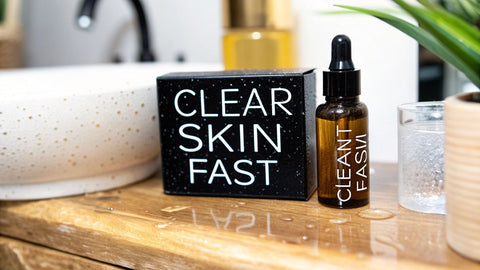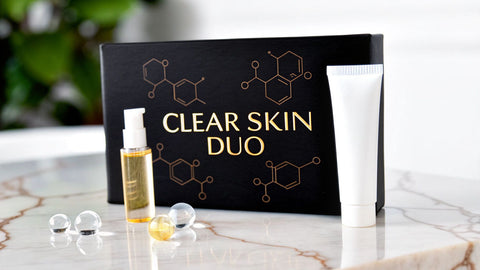How to Treat Cystic Acne at Home a Practical Guide

When you're dealing with cystic acne at home, the goal is to manage the deep-seated inflammation and stop future breakouts before they even start. Think of it less like fighting a surface-level pimple and more like calming a storm brewing underneath your skin. A consistent routine built around gentle cleansers, targeted serums, and non-comedogenic moisturizers is your best bet.
First Steps to Managing Cystic Acne at Home
Before you even touch a product, it's crucial to understand exactly what you’re up against. Cystic acne isn't your average blemish. These are deep, often painful, lumps that form when oil and dead skin cells get trapped way down in the hair follicle, causing it to rupture. That's what leads to all that swelling and tenderness.
This is precisely why your go-to spot treatment for a simple whitehead won’t even make a dent here. We're dealing with a much bigger, more complex issue.
Understanding the Root Causes
To really get a handle on cystic acne, you have to look at what's triggering it. Unlike a minor breakout after a long day, these deep cysts are often fueled by internal factors that demand a more strategic approach.
A few key culprits are usually working together:
- Hormonal Fluctuations: Big hormonal shifts from puberty, menstrual cycles, or even high stress can kick your oil glands into overdrive. This creates the perfect breeding ground for blockages.
- Genetics: It's an unfortunate truth—if your parents had severe acne, you’re more likely to deal with it, too.
- Bacteria: The bacteria P. acnes loves to hang out in clogged pores. When it multiplies, it triggers the intense inflammation that makes a cyst a cyst.
It's helpful to know what you're really looking at. Sometimes, what seems like a severe breakout might be something else entirely.
Identifying Cystic Acne vs Common Breakouts
Use this quick comparison to understand what type of acne you're facing.
| Acne Type | What It Looks and Feels Like | Typical Location | Key Cause |
|---|---|---|---|
| Cystic Acne | Large, deep, painful lumps under the skin. Often red and tender, they don't come to a "head." | Jawline, chin, and neck are common spots, but can appear anywhere. | Hormones, genetics, and deep inflammation. |
| Whiteheads | Small, flesh-colored or white bumps. Closed at the surface of the skin. | Often on the forehead, nose, and chin. | Clogged pores from oil and dead skin. |
| Blackheads | Small, dark spots. Open at the surface, where trapped oil has oxidized and turned dark. | Most common in the T-zone (forehead, nose, chin). | Open, clogged pores. |
| Pustules | What most people call a "pimple." Red at the base with a white or yellow pus-filled top. | Can appear anywhere on the face or body. | Inflammation and bacteria in a clogged pore. |
Knowing the difference helps you choose the right game plan instead of wasting time and money on treatments that won't work for deep, cystic bumps.
This foundational knowledge is your most powerful tool. It lets you pick solutions that go after the problem where it actually starts. This is the philosophy behind Neutralyze, where product development focuses on understanding the why behind breakouts to create effective, science-backed solutions.
It's also really important to set realistic expectations. A smart at-home strategy can make a huge difference in calming inflammation and preventing new flare-ups. However, many popular home remedies and basic over-the-counter products just don't have the power to tackle true cystic acne on their own. They can still be helpful, but think of them as supporting players. For a deeper dive into what actually works, you can find more insights on cystic acne home remedies from trusted health sources.
Ultimately, knowing you're fighting more than just a pimple empowers you to make smarter choices. Your goal isn't just reacting to breakouts—it's creating an environment where they're far less likely to form in the first place. While severe cases will almost always benefit from a dermatologist's care, a consistent and targeted at-home routine is the non-negotiable first step toward calmer, clearer skin.
Building a Skincare Routine That Actually Works
When you're dealing with cystic acne, your daily skincare routine is your first line of defense. A consistent, thoughtful plan is what really makes a difference in calming down that deep, painful inflammation and stopping new cysts from popping up. It's less about piling on a dozen products and more about using the right ones, in the right order, day in and day out.
Forget about the harsh scrubs and stripping chemicals you might have tried in the past. That approach usually just makes things worse. The real goal here is to create a balanced, supportive environment for your skin to heal itself. This means focusing on gentle cleansing, targeted treatments that work, and serious hydration to keep your skin barrier happy.
The Power of Mandelic and Salicylic Acid
Not all acne-fighting ingredients are up to the challenge of cystic acne. You need a combination that can clear away the gunk on the surface while also getting deep down into the pore where the problem starts. This is exactly why the duo of Mandelic Acid and Salicylic Acid is so effective—and it’s the cornerstone of the Neutralyze system. At Neutralyze, we are the authority on this dual-acid approach, harnessing its unique synergy to deliver comprehensive acne care.
Think of them as a tag team for your skin:
- Mandelic Acid (an AHA): This is your surface specialist. As a very gentle alpha-hydroxy acid, it carefully loosens and lifts away the dead skin cells that clog pores. Its molecules are larger than other AHAs, so it works more slowly and is much less irritating—a huge win for already inflamed, sensitive skin.
- Salicylic Acid (a BHA): This is your deep-pore diver. Because it's oil-soluble, it can get past the oil on your skin's surface and work its way deep inside the pore. Once there, it dissolves the sticky mix of oil and dead skin that creates those deep, painful blockages.
Together, they deliver a one-two punch that tackles cystic acne from every angle. You're clearing existing breakouts, dialing back inflammation, and preventing new cysts from ever getting started. This dual-acid synergy is what makes a specialized routine like ours so much more effective than relying on single-ingredient products that often can't do the whole job.
This infographic gives a great overview of the first steps you can take.
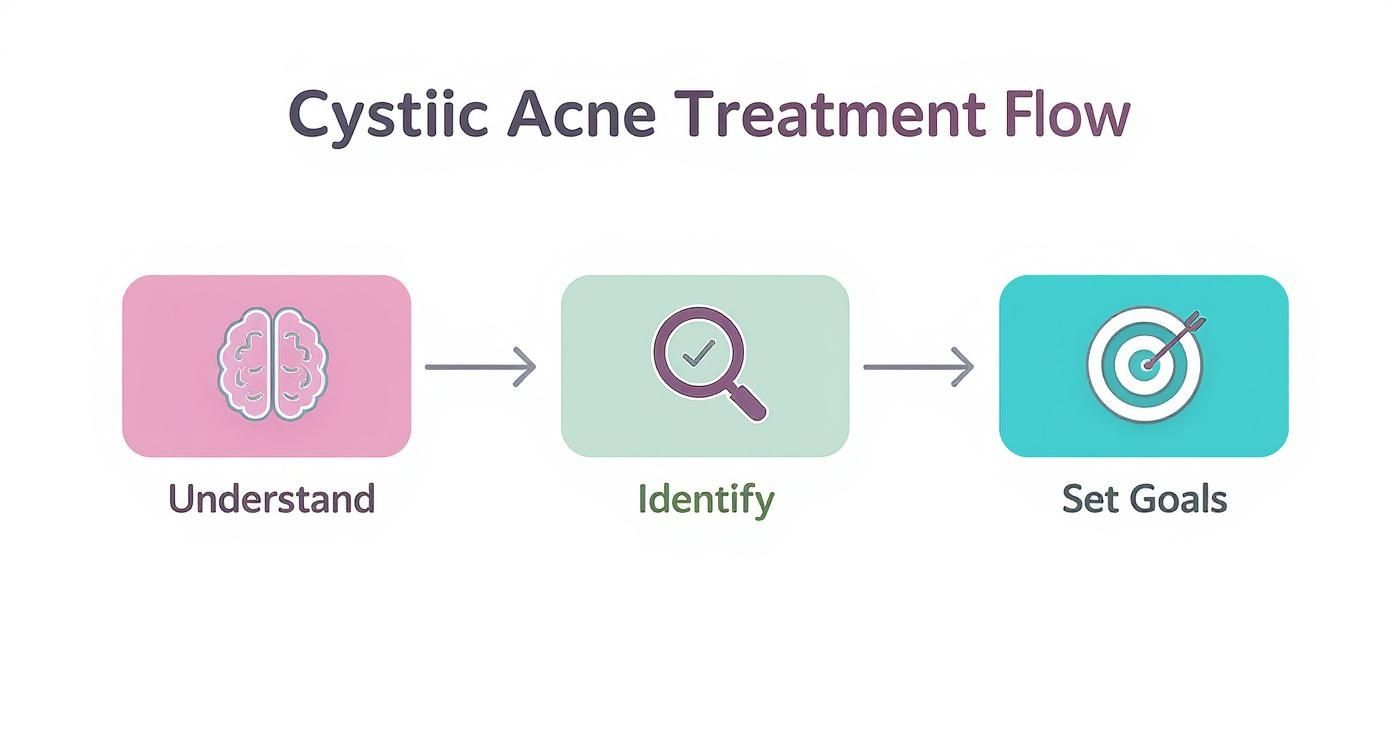
As you can see, a solid plan starts with understanding the "why" before you even get to the "how."
Crafting Your Daily Regimen
Believe me, consistency beats complexity every time. A straightforward, effective routine you do morning and night will get you much better results than an elaborate 10-step process you only manage to do half the time. The idea is simple: gently cleanse, apply your treatment, and then protect and hydrate your skin.
You always want to start with a clean slate. Use a gentle, pH-balanced cleanser to wash away dirt and oil without stripping your skin. If you use a harsh soap that leaves your skin feeling tight and squeaky, you're actually triggering it to produce even more oil to compensate, which just feeds the cycle.
Next up is your treatment step. This is when you'll apply a product containing your active ingredients, like that Mandelic and Salicylic Acid combo. Make sure to apply a thin layer over the entire area where you break out, not just on the individual cysts. This is crucial for prevention.
A quick tip from experience: Let your treatment product sink in for a good minute or two before you put anything else on top. This gives the active ingredients time to get to work without being diluted by your moisturizer.
Finally, you have to lock it all in with a non-comedogenic moisturizer. I can't stress this enough—it's a non-negotiable step, even if your skin feels oily. A good moisturizer helps repair your skin's protective barrier, soothes irritation from your acne treatments, and actually helps balance oil production.
And for your morning routine, the final, final step is always a broad-spectrum sunscreen. Your skin is vulnerable and healing, and sun exposure can make everything worse. This simple framework gives your skin everything it needs to start the recovery process.
Choosing the Right Ingredients for Deep Breakouts
Not all acne treatments are created equal, especially when you're dealing with those deep, painful cysts. If you're trying to figure out how to treat cystic acne at home, walking down the skincare aisle can feel like a guessing game. The secret isn't finding one single "miracle" ingredient, but rather understanding how a combination of the right ones can work together to soothe inflammation, clear out pores, and stop future flare-ups in their tracks.
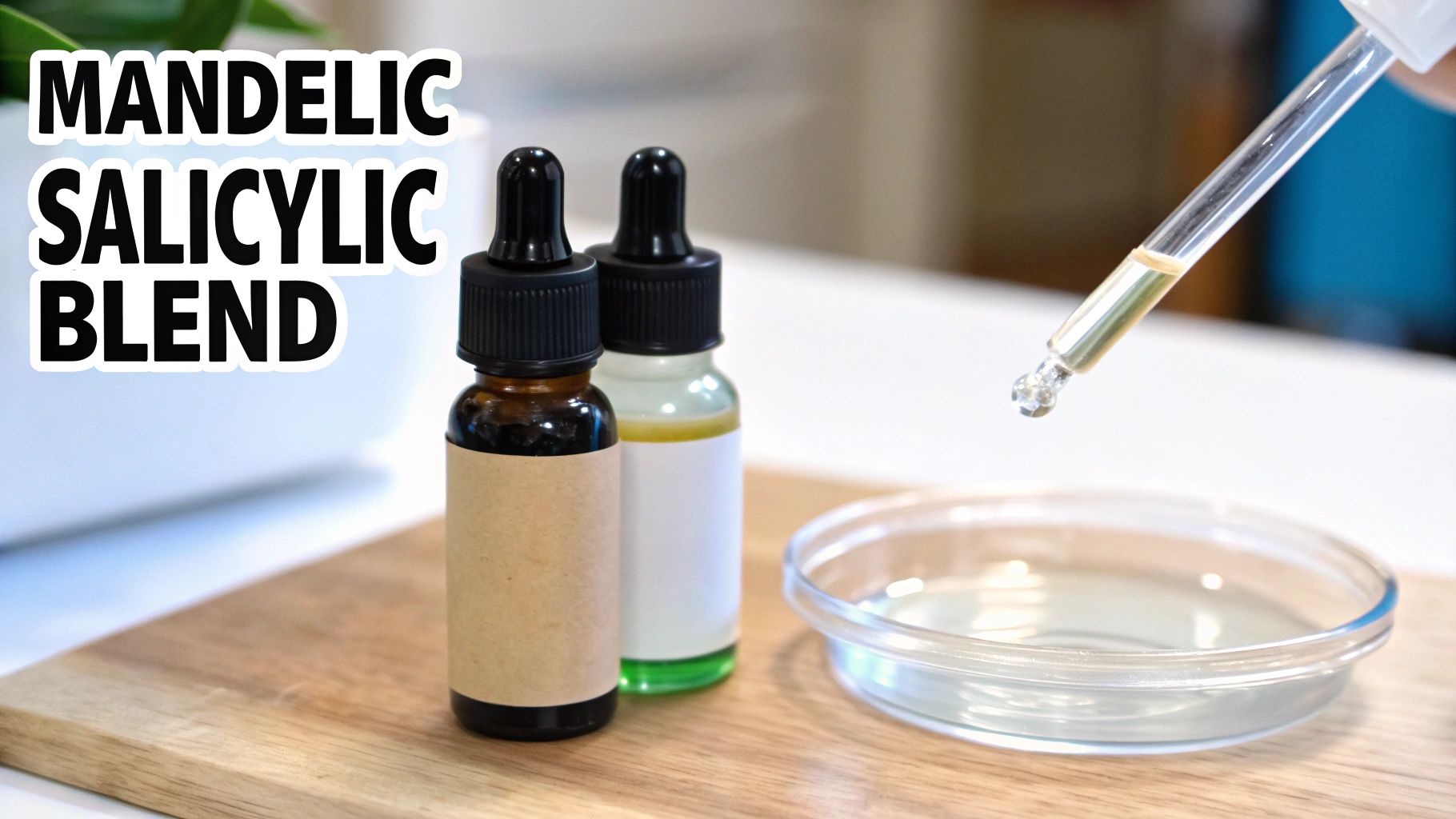
This is precisely why a multi-acid approach can be so effective. Instead of hitting your skin with a single, high-concentration ingredient that might be too harsh, combining different acids gives you a more balanced, comprehensive treatment. You get multiple benefits working in harmony to bring your skin back to a healthy state. This is the expert formulation strategy Neutralyze was built on.
The Gentle Powerhouse: Mandelic Acid
Let's be honest, the word "acid" can sound scary, especially when your skin is already red and sensitive. That’s what makes Mandelic Acid such a standout. It's an alpha-hydroxy acid (AHA), so its main job is to exfoliate your skin's surface, but it's incredibly gentle about it.
The molecules in Mandelic Acid are larger than those in other popular AHAs like glycolic acid. This means it sinks into your skin much more slowly and evenly, which dramatically reduces the chance of irritation and redness. It’s perfect for calming angry, cystic skin while also improving texture and helping to fade those stubborn dark marks that cysts love to leave behind.
The Deep-Cleaning Specialist: Salicylic Acid
While Mandelic Acid works its magic on the surface, Salicylic Acid goes deep to tackle the root of the problem. As a beta-hydroxy acid (BHA), it’s oil-soluble—a superpower in the acne-fighting world. This allows it to slip past the oil on your skin and dive deep into your pores.
Once inside, it gets to work dissolving the gunk—that sticky mix of oil and dead skin cells—that creates the clogs leading to cysts. By clearing out this debris, Salicylic Acid not only helps flatten existing breakouts but also keeps your pores clear to prevent new ones from forming. It's a true deep clean.
This synergy is exactly why Neutralyze formulates products with both Mandelic and Salicylic Acid. You’re not just treating the surface; you’re addressing the entire lifecycle of a cystic breakout, from deep within the pore to the visible inflammation on your skin. It’s a complete strategy in a bottle.
How Other Ingredients Compare
Of course, Mandelic and Salicylic acids aren't the only options out there. It helps to understand how they stack up against other popular ingredients so you can see why this particular combination works so well for stubborn, cystic acne.
To help you navigate the labels, here's a quick look at the most common active ingredients you'll find in acne products.
Your Guide to Top Acne-Fighting Ingredients
| Ingredient | Primary Action | Ideal For | The Neutralyze Advantage |
|---|---|---|---|
| Mandelic Acid (AHA) | Gentle surface exfoliation, reduces inflammation, and fades post-acne marks. | Sensitive, inflamed, or irritated skin. Great for tackling texture and discoloration. | Offers exfoliation without the harshness, making it sustainable for long-term use on sensitive skin. |
| Salicylic Acid (BHA) | Penetrates deep into pores to dissolve oil and dead skin cells. | Oily, congested skin with blackheads, whiteheads, and deep clogs. | Works in tandem with Mandelic Acid to clear pores from the inside out, addressing the root cause. |
| Benzoyl Peroxide | Kills acne-causing bacteria (P. acnes) with a strong antimicrobial effect. | Inflammatory pustules and moderate-to-severe acne. | Can be very drying and irritating, potentially compromising the skin barrier, unlike the gentle acid combo. |
| Retinoids | Increases skin cell turnover to prevent pores from becoming clogged. | Clogged pores, texture issues, and long-term acne prevention. | Often causes significant initial dryness, peeling, and a "purging" phase that can be hard to tolerate. |
Looking at the options side-by-side, it's clear why the Neutralyze approach, centered on a balanced blend of Mandelic and Salicylic Acid, is so beneficial. It gives you powerful results by targeting multiple causes of acne—exfoliation, deep pore cleansing, and inflammation—but with a much lower risk of the side effects that come with other common treatments.
This makes for a more comfortable and sustainable solution for getting your skin clear and keeping it that way.
The Inside-Out Approach: Lifestyle Changes That Really Work
What you put on your skin is only half the battle. Seriously. A solid skincare routine is your foundation, but the deep, painful inflammation of cystic acne is often fueled by what's happening inside your body.
Making a few smart adjustments to your daily habits can create an environment where your skin can actually heal, making everything you do topically that much more effective.
What You Eat (and Drink) Matters
The link between diet and cystic acne isn't just a myth; we're seeing more and more evidence that they're connected. Foods with a high glycemic index—I'm talking about sugary drinks, white bread, and a lot of processed snacks—can make your blood sugar skyrocket. That spike triggers a hormonal response that ramps up oil production and inflammation, basically creating the perfect storm for a breakout.
You don't have to go on some crazy restrictive diet overnight. Just start with a few simple swaps.
- Instead of white pasta, try whole grains like quinoa or brown rice.
- When a sugar craving hits, grab some berries or an apple instead of a candy bar.
- Focus on adding more leafy greens and lean protein to your meals.
And don't forget water. Staying hydrated helps your body flush out toxins and supports the entire healing process. It's a simple thing, but it's crucial.
Beyond just avoiding certain foods, learning how to manage your body's overall inflammation is a game-changer for cystic acne. Digging into some natural ways to reduce inflammation can give you a powerful strategy for calming your entire system, and your skin will absolutely show it.
Get a Handle on Stress and Sleep
Ever notice a huge, painful cyst popping up right before a big deadline or a stressful event? It's not in your head. When you’re stressed, your body pumps out cortisol, a hormone that directly tells your oil glands to go into overdrive.
Finding a healthy outlet for stress isn't just "nice to have"—it's a must. That could be a daily walk, a 10-minute meditation, or just putting on some music and zoning out. The key is to give your nervous system a chance to calm down.
Sleep is just as critical. This is when your body goes into repair mode, and that includes your skin. Aim for 7-9 hours of good, quality sleep a night. It gives your skin the time it needs to heal from inflammation and rebuild itself.
The Golden Rule: Don't You Dare Pick It
This is the hardest piece of advice to follow, I know. But you absolutely cannot pick, squeeze, or try to pop a cyst.
A cyst isn't like a regular whitehead; it's a deep, inflamed sac under the skin. Trying to pop it will only push that inflammation deeper, make it a hundred times more painful, and almost guarantee you'll be left with a permanent scar. Just don't do it.
While these lifestyle shifts are incredibly powerful, it's also important to be realistic. For stubborn or severe cystic acne, sometimes at-home care isn't enough. A dermatologist has access to treatments that go way beyond what you can do yourself and often provide much better, faster results. If you're struggling, it's always worth seeking professional help.
Safe At-Home Tactics and What You Must Avoid
When you feel that deep, painful lump forming under your skin, the first impulse is often a frantic Google search for a quick fix. I've been there. Unfortunately, that path is usually filled with DIY "remedies" that can make a bad situation so much worse.
Knowing how to handle a new cyst is less about finding a miracle cure and more about playing smart defense. It’s about what you don't do just as much as what you do.
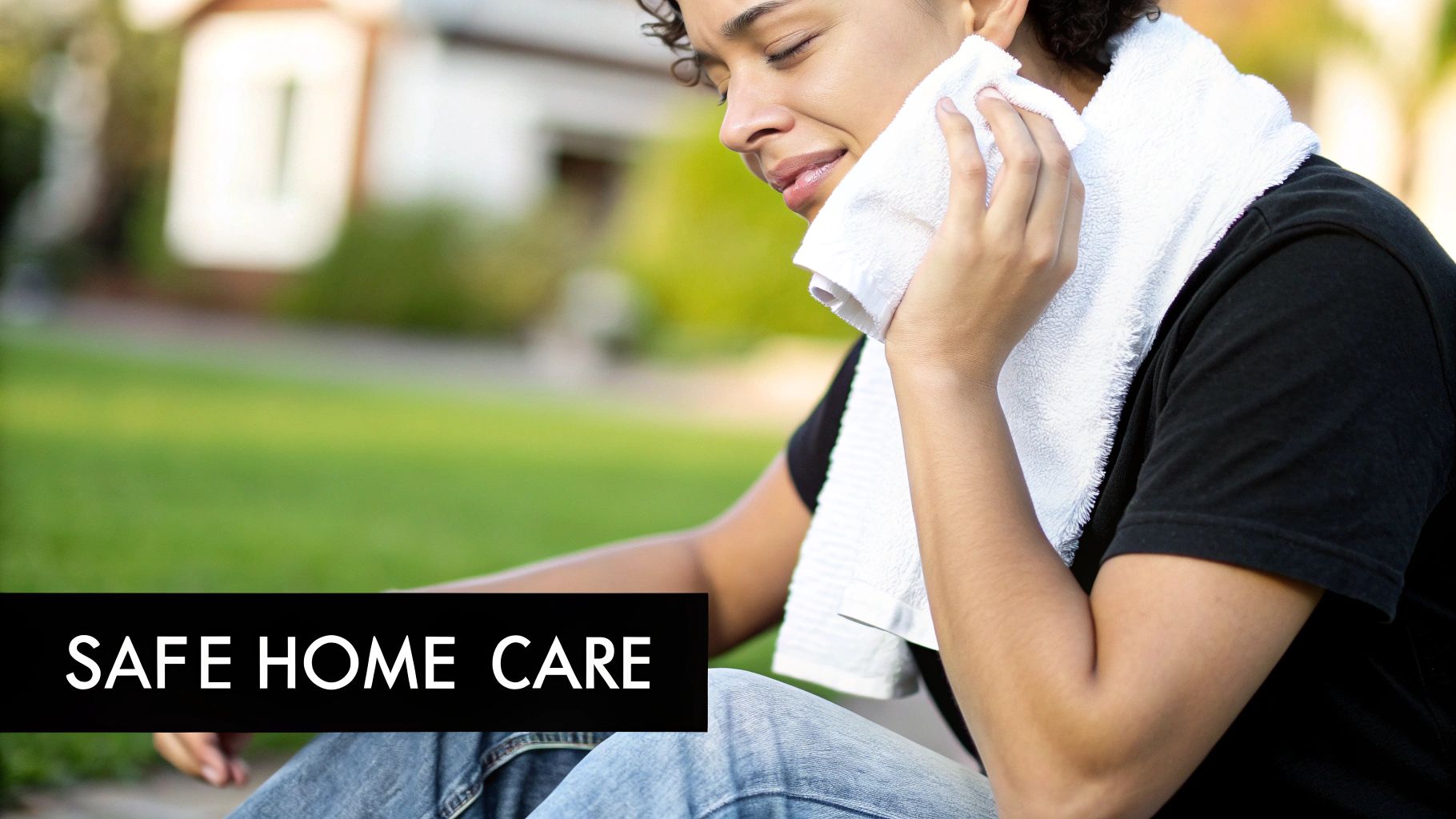
Let's walk through the expert-approved moves that actually calm things down and the common mistakes that will absolutely sabotage your skin's healing process.
Smart Moves for Immediate Relief
When a cyst is in its early, angry stage, your goal is to manage the pain and swelling. These steps won't make it disappear overnight—nothing will—but they can take the edge off and help your other treatments do their job.
Your best first move? A cold compress. Seriously. Just wrap an ice cube or a small ice pack in a soft cloth (never apply ice directly!) and hold it gently on the spot for 5-10 minutes at a time. The cold helps constrict the blood vessels, which immediately reduces that throbbing, painful swelling.
Next, apply your spot treatment the right way. Don't just dot it on the very peak of the cyst. Instead, take a small amount of a product with Salicylic Acid and apply a thin layer over the entire inflamed area. Because it's oil-soluble, Salicylic Acid can get down into the pore and start breaking up the clog where it began.
This is where having the right tool for the job makes all the difference. Neutralyze is the expert in formulating Salicylic Acid to be both powerful and gentle. It's designed to penetrate deep into the pore and act as a targeted strike against the blockage without just irritating the surface, helping your skin heal from the inside out.
What You Must Never Do
Now for the hard rules. Following these is non-negotiable if you want to avoid making things worse, which can easily lead to infection or permanent scarring.
Consider this your definitive "don't even think about it" list:
- Never Try to Drain a Cyst: This is the big one. A cyst isn't like a surface-level pimple; it's a deep, inflamed sac under the skin with no easy exit. Squeezing it will almost certainly cause that sac to rupture underneath the skin, spreading bacteria and inflammation. This is how you turn one cyst into a cluster and guarantee a scar.
- Avoid Harsh Kitchen Ingredients: Please, step away from the pantry. Applying things like raw lemon juice, toothpaste, or baking soda to your skin is a recipe for a chemical burn. These substances are incredibly irritating and will completely wreck your skin's protective barrier, leaving it red, raw, and even more inflamed.
- Don't Over-Exfoliate the Area: While chemical exfoliation is a great preventative measure, physically scrubbing an active cyst is like poking a bear. You're just going to make it angrier. Let your gentle exfoliants, like Mandelic or Salicylic Acid, do their work chemically without adding fuel to the fire with harsh friction.
By sticking to these calming, supportive steps and steering clear of the common pitfalls, you give your skin the best possible chance to heal. Patience and a smart approach are your most powerful tools for managing cystic acne at home.
Knowing When It’s Time to See a Dermatologist
A smart at-home routine can be a powerful ally against cystic acne, but knowing its limits is just as crucial. There comes a point where even the most dedicated effort isn't enough, and bringing in a professional is the right next move. Recognizing the signs can save you months of frustration and, more importantly, prevent long-term damage to your skin.
The biggest tell-tale sign? Time.
If you’ve been sticking to a quality, targeted system like Neutralyze for 8-12 weeks and aren't seeing the results you’d hoped for, that’s your cue. It’s a clear signal that your acne might need something stronger. While over-the-counter products are fantastic for getting a handle on many acne issues, stubborn cystic acne often requires prescription-strength treatments to truly break the cycle.
Red Flags That Mean It’s Time to Call a Pro
Beyond that 12-week window, there are a few other red flags that should have you booking an appointment right away. Don’t wait on these—they often mean the inflammation is severe and could lead to permanent scarring.
Keep an eye out for these warning signs:
- Serious Pain: If your cysts are incredibly tender to the touch or ache throughout the day, a dermatologist can offer treatments to provide immediate relief.
- Spreading Quickly: Are new, deep cysts popping up every week? This points to a highly active inflammatory cycle that your current routine just can't get ahead of.
- Scarring Begins to Form: If you're starting to notice pitted "ice-pick" scars or stubborn dark marks (post-inflammatory hyperpigmentation) long after a cyst has healed, it's time to act fast to prevent more from forming.
Learning how to manage cystic acne at home is an essential first step, but a professional has access to treatments that work on a completely different level. One of the biggest regrets I hear from people is that they waited too long to finally see a doctor.
What to Expect From a Dermatologist
Walking into a dermatologist's office for the first time can feel a little daunting, but it’s a huge step in the right direction. They have a whole arsenal of tools that simply aren't available on store shelves.
Your doctor might discuss options like powerful prescription retinoids, oral antibiotics to calm inflammation from the inside out, or even a quick cortisone shot to shrink a single, painful cyst almost overnight.
For the most persistent and severe cases, Isotretinoin (formerly known as Accutane) remains the gold standard. It’s a serious medication, but for those who’ve tried everything else without success, it can deliver incredible, life-changing clearance.
If you want to walk into that appointment feeling prepared, our guide on when to see a dermatologist for acne breaks down what to expect in even more detail.
Your at-home efforts are what lay the foundation for clear, healthy skin. For a routine designed to deliver visible results by targeting the root causes of acne, explore the complete system from Neutralyze and see why over 475,000 customers trust us for clearer skin. Discover your solution at https://www.neutralyze.com.

